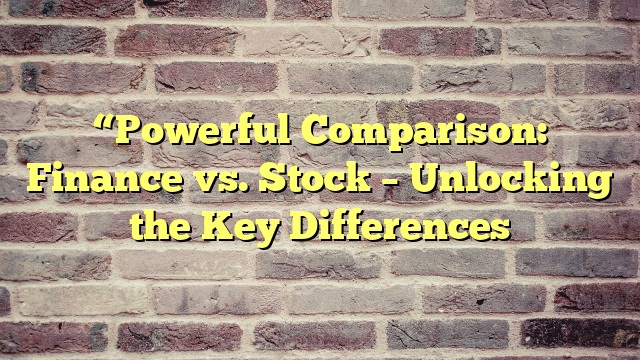Introduction: Understanding the Financial World
In today’s fast-paced and ever-changing world, understanding the financial landscape is crucial for individuals and businesses alike. Two key players in the financial world are finance and stock. While both may seem similar, they have fundamental differences that set them apart. In this article, we will delve into the key differences between finance and stock, uncovering the unique qualities that make them stand out. So let’s begin our journey of unlocking the key differences between finance and stock.
Subheading 1: Finance: A Comprehensive Overview
When we talk about finance, we refer to the management of money and assets. It includes various activities such as budgeting, investing, saving, and borrowing. The ultimate goal of finance is to maximize wealth and create financial stability. It is a broad term that encompasses many aspects, including personal finance, corporate finance, and public finance. Personal finance deals with managing an individual’s money, while corporate finance focuses on managing a company’s financial resources. On the other hand, public finance deals with the management of government revenues and expenditures.
Subheading 2: Stock: The World of Investments
Stock is a type of financial instrument that represents ownership in a company. When an individual purchases a stock, they become a shareholder in that company. Stock is traded on the stock market, and its value can fluctuate based on several factors such as company performance, market conditions, and investor sentiment. Investors can buy and sell stocks in the stock market to earn a profit or generate income through dividends. Stocks are a popular investment option for individuals looking to grow their wealth.
Subheading 3: Key Differences between Finance and Stock
While finance and stock may seem related, they have fundamental differences that set them apart. Some of the key differences between finance and stock are:
– Scope: Finance is a broader term that includes various aspects such as budgeting, investing, and borrowing. On the other hand, stock is a specific type of investment instrument.
– Risk: Finance involves managing money and assets, which can have varying levels of risk. Stock, on the other hand, is considered a riskier investment option as its value can fluctuate greatly.
– Ownership: In finance, individuals or businesses own their money and assets. In contrast, when an individual invests in stocks, they become a partial owner of the company.
– Returns: The returns in finance can vary depending on the investment option chosen, but they are usually lower than stock returns. Stock, on the other hand, can provide higher returns but also carries a higher risk.
Subheading 4: Focus Keyword: Investment Options in Finance and Stock
When it comes to investing, individuals have various options in both finance and stock. Let’s take a closer look at some popular investment options in both categories.
In Finance:
1. Bonds: Bonds are a type of loan where individuals lend money to a company or government entity in exchange for a fixed rate of return.
2. Mutual Funds: Mutual funds are a type of investment where individuals pool their money to invest in a variety of assets such as stocks, bonds, and real estate.
3. Real Estate: Individuals can invest in real estate by purchasing properties or through real estate investment trusts (REITs).
4. Certificates of Deposit (CDs): CDs are a type of savings account where individuals invest a fixed amount for a fixed period, and in return, receive a fixed interest rate.
In Stock:
1. Individual Stocks: As the name suggests, individual stocks refer to buying and owning shares of a specific company.
2. Exchange-Traded Funds (ETFs): ETFs are similar to mutual funds, but they are traded on the stock market like individual stocks.
3. Options: Options are a type of derivative contract that gives individuals the right to buy or sell a stock at a specific price within a certain time frame.
4. Index Funds: Index funds track a specific market index, such as the S&P 500, and provide investors with exposure to a diverse group of stocks.
Subheading 5: Investment Strategies: Finance vs. Stock
When it comes to investing, having a solid strategy is crucial for success. Let’s take a look at the different investment strategies used in finance and stock.
In Finance:
1. Diversification: Diversification is a strategy where individuals invest in a variety of assets to minimize risk.
2. Buy and Hold: Buy and hold is a strategy where individuals invest in a stock or asset for the long term, holding it even during market fluctuations.
3. Dollar-Cost Averaging: This strategy involves investing a fixed amount of money at regular intervals, regardless of market conditions.
In Stock:
1. Active Trading: Active trading involves buying and selling stocks frequently to take advantage of short-term market movements.
2. Value Investing: Value investing involves identifying undervalued stocks and investing in them for long-term growth.
3. Growth Investing: Growth investing involves investing in stocks

